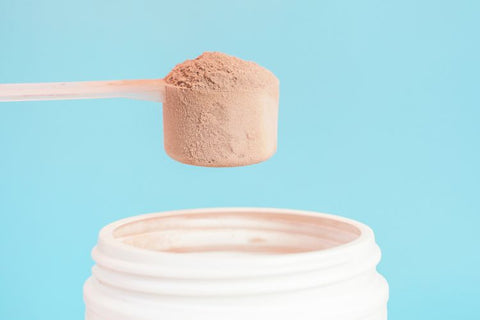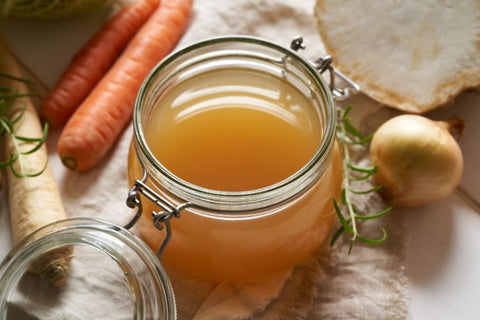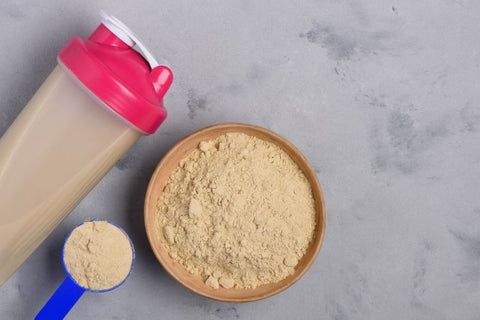In the realm of fitness and nutrition, protein powders reign supreme. These concentrated sources of protein fuel various goals, from muscle building to weight management. But as their popularity soars, understanding accurate protein powder scoop sizes becomes vital.
This article sets the stage for exploring the widespread use of protein powders and the crucial role of precise measurement in navigating the world of these supplements. By delving deeper, we'll uncover the benefits, versatility, and importance of using a kitchen scale for accurate serving sizes, empowering you to harness the full potential of protein powders in your journey toward a healthier you.
Varied Scoop Sizes
There's no universal scoop size for protein powder! The amount you get in a scoop can vary depending on the brand and type of protein. Here's a breakdown of the common scoop size range you mentioned (25-35 grams) and why there are differences:
-
Range: Typically, protein powder scoops fall between 25-35 grams. This range reflects the protein concentration of the powder itself.
-
Concentration Matters: Powders with a higher protein content per gram can have smaller scoops (around 25 grams) and still deliver the recommended protein serving. Conversely, powders with lower protein concentrations might need larger scoops (up to 35 grams) to provide the same amount of protein.
- Brand Variation: Even within similar protein types, brands can have different scoop sizes. This depends on their specific formulation and how densely the powder packs in the scoop.
Protein Density and Scoop Size
You might be surprised to find that protein powder scoops aren't one-size-fits-all. They can range from 25 to 35 grams, and this variation has to do with the type of protein and its density. Let's delve into how protein density impacts scoop size and see the difference between whey protein and plant-based protein powders in terms of scoop size for the same amount of protein. Here's how:
Density Dictates Scoop Size:
- Density Defined: Protein density refers to the amount of protein packed into a specific volume (e.g., grams per cubic centimetre).
- High Density, Small Scoop: Protein sources like whey protein isolate tend to be denser. This means you can get a higher amount of protein in a smaller scoop size. Think of it like packing sand vs. marshmallows; sand (denser) holds more weight in a smaller volume than marshmallows (less dense).
- Low Density, Larger Scoop: Plant-based protein sources, like pea protein or brown rice protein, are generally less dense than whey protein. To deliver the same amount of protein, you'll need a larger scoop size to compensate for the lower density.
Standardized Scoops
While there isn't a universal "one scoop equals X grams" rule for protein powder, manufacturers do include scoops for a reason. These standardized scoops, as they're intended to be, aim to simplify serving measurements for consumers.
Here's how they offer a benefit:
-
Convenience: Scoops eliminate the need for consumers to measure out each serving with separate measuring tools like spoons or scales. This is especially helpful when on the go or at the gym.
-
Consistency: In theory, using the provided scoop ensures you're getting close to the recommended serving size listed on the label. This consistency is crucial for tracking your daily protein intake.
However, it's important to remember that these scoops aren't perfectly standardized across the industry. As we discussed earlier, protein density and brand variations can affect the actual amount of powder a scoop holds.
Protein Content per Scoop
Protein powder scoop sizes can be like a magic trick – same container, different amounts! This variation hinges on several key factors that influence the protein content per scoop. Let's explore these factors and how they affect the scoop size you encounter:
-
Protein Concentration: This is the main culprit. Protein powders boast varying protein concentrations, typically ranging from 60% to 90%. Here's the connection:
- Higher Concentration, Smaller Scoop: Powders with a higher protein content per gram can afford to have smaller scoops (think 25 grams) and still deliver the intended protein serving.
- Lower Concentration, Larger Scoop: Conversely, powders with a lower protein concentration need larger scoops (up to 35 grams) to provide the same amount of protein. It's like packing more balloons (lower protein density) into a box compared to heavier bowling balls (higher protein density).
-
Protein Source: The type of protein used also plays a role. Whey protein isolate, for example, is generally denser than plant-based proteins like pea or brown rice. This naturally leads to a difference in scoop size for the same protein content.
-
Fillers and Additives: Some protein powders contain fillers and additives like carbohydrates, fats, and flavourings. These add volume to the powder without contributing much protein. Powders with more fillers might have a larger scoop size to accommodate the additional bulk, even if the actual protein concentration is decent.
Serving Recommendations
Protein powder can be a valuable tool for athletes, fitness enthusiasts, and anyone looking to increase their protein intake. But with all the variations in scoop sizes, it's easy to wonder: does the amount you consume matter? The answer is yes, following the recommended serving sizes on the protein powder label is important for several reasons:
-
Accurate Protein Intake: The primary function of protein powder is to provide a convenient and measured dose of protein. The serving size listed on the label reflects the amount of protein the manufacturer intended you to consume per scoop. Following these guidelines ensures you're getting the targeted protein amount to support your goals, whether it's muscle building, recovery, or satiety.
-
Potential Health Concerns: Exceeding the recommended serving size can lead to unintended consequences. Here are some potential issues:
- Kidney Strain: Our bodies can only process a certain amount of protein efficiently. Excessive intake can put stress on your kidneys, especially for individuals with pre-existing kidney conditions.
- Digestive Issues: Consuming too much protein at once can lead to bloating, gas, and other digestive discomfort.
- Nutrient Imbalance: Focusing heavily on protein powder can crowd out other essential nutrients from your diet if you're not careful.
- Label Transparency: The serving size on the label is determined based on the specific protein blend and its intended use. It factors in things like protein concentration, ingredients, and potential health benefits. Following the recommended serving size allows you to experience the product as intended.
Adjusting for Personal Goals
While protein powder labels provide recommended serving sizes, individuals can adjust scoop usage to meet their specific fitness or dietary goals. Here's how:
Understanding Your Needs:
First, consider your overall protein needs and goals. Factors like activity level, muscle mass, and weight loss/gain targets all influence protein requirements. A general guideline suggests 0.8-1 gram of protein per pound of body weight for most individuals. However, athletes or those trying to build muscle may require more (up to 1.2-1.5 grams per pound).
Scenario-Based Scoop Adjustments:
Let's explore some examples of how to tailor scoop servings based on objectives:
-
Muscle Building: If you're aiming to build muscle mass, you might slightly increase your scoop size from the recommended serving to achieve a higher daily protein intake. However, exceeding recommended serving sizes by a large margin is generally not advised. It's better to consult a healthcare professional or nutritionist for personalized guidance.
-
Weight Loss: When aiming for weight loss, protein can help with satiety and manage calorie intake. You might use the recommended serving size or even a slightly reduced scoop size as part of a calorie-controlled diet. Remember, protein powder shouldn't replace whole foods in your weight loss plan.
- Maintaining Muscle Mass: For individuals looking to maintain their current muscle mass, following the recommended serving size on the label is likely sufficient, assuming they're consuming enough protein through their diet as well.
Influence of Flavor and Additives
Flavouring and additives can impact the scoop volume of protein powder, influencing the amount of powder you get in a single serving. Here's how:
The Fill Factor:
Flavouring and additives act as fillers, adding bulk to the powder without necessarily contributing much protein content. This means manufacturers often need to adjust the scoop size to accommodate these extra ingredients while still delivering the intended protein serving size listed on the label.
Impact on Scoop Size:
-
Increased Scoop Size: Protein powders with a significant amount of flavouring, sweeteners, thickeners, or other additives will likely have a larger scoop compared to a similar protein powder with minimal extras. This is because the larger scoop allows them to deliver the same protein content per serving while providing those extra flavouring ingredients.
- Density Matters: The density of the flavourings and additives also plays a role. Dense flavourings might take up less space in the scoop compared to lighter, fluffier ingredients. This can influence the variation in scoop size even among flavored protein powders.
Caloric Contribution
Protein powder can be a valuable tool for weight management, but it's important to understand its caloric contribution. Here's how to scoop size and protein powder content factor into your calorie intake:
Calories per Scoop:
Protein powder isn't calorie-free. While the primary focus is protein content, most powders contain some calories due to:
- Protein Itself: Protein provides 4 calories per gram.
- Carbohydrates and Fats: Some powders contain carbohydrates (for sweetness or thickening) and fats (sometimes from added ingredients like MCT oil). These add to the overall calorie count.
The exact number of calories per scoop varies depending on the brand, protein source, and additional ingredients. It typically falls within the range of:
- 60-120 calories per scoop for whey protein powders.
- 90-140 calories per scoop for plant-based protein powders (due to potentially higher content of carbs and fats from plant sources).
Conclusion
Understanding protein powder scoop sizes is key to making informed choices about your nutrition and fitness. By recognizing the factors that influence scoop size and serving recommendations, you can maximize the benefits of protein powders while avoiding potential pitfalls associated with overconsumption. Consistency and moderation are key to achieving your health and fitness goals with protein supplementation.
Key Takeaways
- There is no universal scoop size for protein powder; it can range from 25-35 grams depending on the brand and type of protein.
- Higher protein concentrations allow for smaller scoops, while lower concentrations may require larger scoops to achieve the same protein serving.
- Different brands can have varying scoop sizes even for similar types of protein due to formulation differences.
- Manufacturers provide scoops for convenience, but these may need to be standardized across the industry.
- Following recommended serving sizes on labels ensures you get the protein amount and prevents potential health issues.
- Tailor scoop sizes based on individual fitness and dietary goals, such as muscle building or weight management.
- Protein powders contain calories from protein, carbs, and fats; be mindful of overall calorie intake.
- Select protein powders based on personal preferences, dietary restrictions, and fitness objectives.
- Supplement, Not Replace: Protein powder should complement a balanced diet, not substitute for whole meals.
- Store Properly: Maintain protein powder freshness by storing it in a cool, dry place away from sunlight and moisture.





